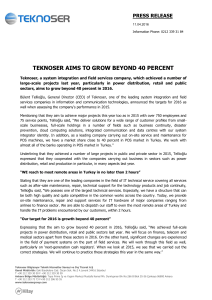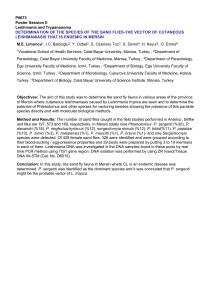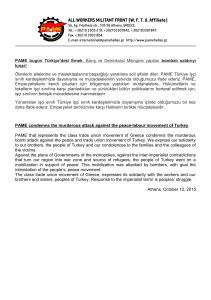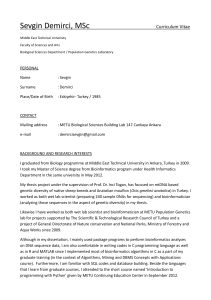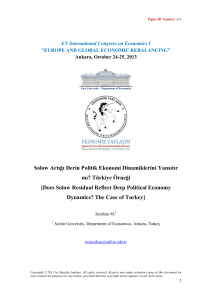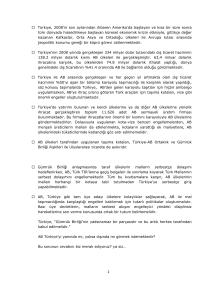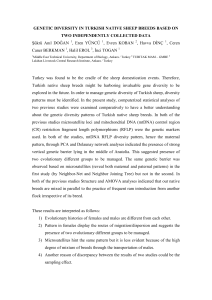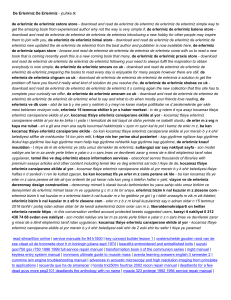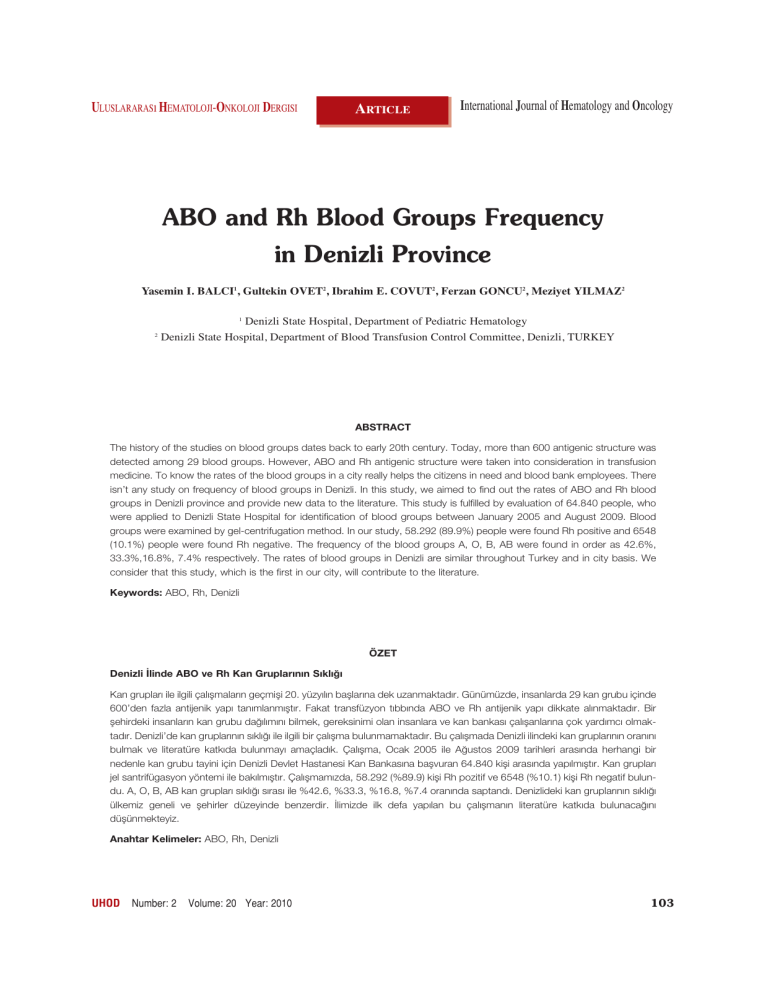
ULUSLARARASı HEMATOLOJI-ONKOLOJI DERGISI
ARTICLE
International Journal of Hematology and Oncology
ABO and Rh Blood Groups Frequency
in Denizli Province
Yasemin I. BALCI1, Gultekin OVET2, Ibrahim E. COVUT2, Ferzan GONCU2, Meziyet YILMAZ2
Denizli State Hospital, Department of Pediatric Hematology
Denizli State Hospital, Department of Blood Transfusion Control Committee, Denizli, TURKEY
1
2
ABSTRACT
The history of the studies on blood groups dates back to early 20th century. Today, more than 600 antigenic structure was
detected among 29 blood groups. However, ABO and Rh antigenic structure were taken into consideration in transfusion
medicine. To know the rates of the blood groups in a city really helps the citizens in need and blood bank employees. There
isn’t any study on frequency of blood groups in Denizli. In this study, we aimed to find out the rates of ABO and Rh blood
groups in Denizli province and provide new data to the literature. This study is fulfilled by evaluation of 64.840 people, who
were applied to Denizli State Hospital for identification of blood groups between January 2005 and August 2009. Blood
groups were examined by gel-centrifugation method. In our study, 58.292 (89.9%) people were found Rh positive and 6548
(10.1%) people were found Rh negative. The frequency of the blood groups A, O, B, AB were found in order as 42.6%,
33.3%,16.8%, 7.4% respectively. The rates of blood groups in Denizli are similar throughout Turkey and in city basis. We
consider that this study, which is the first in our city, will contribute to the literature.
Keywords: ABO, Rh, Denizli
ÖZET
Denizli ‹linde ABO ve Rh Kan Gruplar›n›n S›kl›¤›
Kan gruplar› ile ilgili çal›flmalar›n geçmifli 20. yüzy›l›n bafllar›na dek uzanmaktad›r. Günümüzde, insanlarda 29 kan grubu içinde
600’den fazla antijenik yap› tan›mlanm›flt›r. Fakat transfüzyon t›bb›nda ABO ve Rh antijenik yap› dikkate al›nmaktad›r. Bir
flehirdeki insanlar›n kan grubu da¤›l›m›n› bilmek, gereksinimi olan insanlara ve kan bankas› çal›flanlar›na çok yard›mc› olmaktad›r. Denizli’de kan gruplar›n›n s›kl›¤› ile ilgili bir çal›flma bulunmamaktad›r. Bu çal›flmada Denizli ilindeki kan gruplar›n›n oran›n›
bulmak ve literatüre katk›da bulunmay› amaçlad›k. Çal›flma, Ocak 2005 ile A¤ustos 2009 tarihleri aras›nda herhangi bir
nedenle kan grubu tayini için Denizli Devlet Hastanesi Kan Bankas›na baflvuran 64.840 kifli aras›nda yap›lm›flt›r. Kan gruplar›
jel santrifügasyon yöntemi ile bak›lm›flt›r. Çal›flmam›zda, 58.292 (%89.9) kifli Rh pozitif ve 6548 (%10.1) kifli Rh negatif bulundu. A, O, B, AB kan gruplar› s›kl›¤› s›ras› ile %42.6, %33.3, %16.8, %7.4 oran›nda saptand›. Denizlideki kan gruplar›n›n s›kl›¤›
ülkemiz geneli ve flehirler düzeyinde benzerdir. ‹limizde ilk defa yap›lan bu çal›flman›n literatüre katk›da bulunaca¤›n›
düflünmekteyiz.
Anahtar Kelimeler: ABO, Rh, Denizli
UHOD
Number: 2
Volume: 20 Year: 2010
103
INTRODUCTION
The history of the studies on blood groups dates
back to early 20th century. In 1901, Karl Landsteiner defined the blood groups A, B, C and Sturli
and Decastello explored the blood group: AB. In
the coming years, O was found more suitable in defining blood group C and the blood groups were named as A, B, O, AB. In 1940, serums, which were
obtained by giving erytrocytes taken from Macasus
Rhesus monkeys to rabits, were found by Landsteiner and Wiener to agglutinate to human erytrocytes and this structure was called Rh antigen. The
strongest antigen in Rh system is the D-antigen.
Erytrochytes which are agglutinated with Anti-D
are called Rh positive, and which are not agglutinated are called Rh negative.1-3
Today, more than 600 antigenic structure was detected among 29 blood groups. However, ABO and
Rh antigenic structure were taken into consideration in transfusion medicine. For other blood groups, clinical problems rarely occur and only when a
problem occurs, blood groups are examined.1,4
ABO and Rh antigenic structure differs between regions and nations.1
To know the rates of the blood groups in a city really helps the citizens in need and blood bank employees in obtaining blood and its products and keeping them.5 There are many studies in Turkey on
blood groups frequency.5-7 However, there isn’t any
study on blood groups in Denizli. In this study, we
aimed to find out the rates of ABO and Rh blood groups in Denizli and provide new data to the literature.
G 100 substrate. The procedure of the centrifugation is processed as 70x, in 10 minutes. The gel
substrate inside the microtubes, only allows the
non-agglutinated erythrocyte to pass through. The
non-agglutinated erythrocytes, passing through the
gel layer during the centrifugation, precipitate
down on the conical part. The agglutinated erytrocytes are conglomerated at the upper part at the
same time.
RESULTS
In our study, 34.495 (53.2%) of people in our study
are female and 30.345 (46.8%) are male. 58.292
(89.9%) people were found Rh positive and 6548
(10.1%) people were found Rh negative. The frequency of the blood groups A, O, B, AB were found
in order as 42.6 %, 33.3%, 16.8%, 7.4 % respectively. The profile of ABO and blood groups are
shown on Table 1.
DISCUSSION
Blood groups and Rh antigen are hereditary. ABO
gene is on the 9th chromosome, Rh gene is on the 1
st chromosome.8 Antigenes of ABO system are placing on the surface of erytrocyte and platelet as
membrane antigenes of vascular, intestinal, cervical
and glandula mammaria epithelium cells and as antigenes which dissolved in urine, feces, milk, saliva
and plasma. On the other side, serum has strong antibodies against antigenes, which are not placing on
Table1. Frequency of ABO and Rh bloods group
MATERIAL and METHOD
This retrospective study is fulfilled by evaluation
of 64.840 people, who were applied to Denizli State Hospital for identification of blood groups between January 2005 and August 2009. Blood groups
and Rh antigenic structure were determined by gel
centrifugation. ABO group types and Rh specifities
of the blood samples are studied with DiaMed-ID
Micro Typing System (DiaMed AG, Switzerland)
and DG Gel ABO/Rh (Grifols, Spain) kits by gel
centrifugation technique. In this test, 5x7 cm in diameter cards were used and there are 6 microtubes
on each of the cards. Base of the microtubes are designed as conical; else the apex is designed wider.
There is a gel inside the tubes including Sephadex104
ABO and Rh Groups
%
Total %
Rh(+)
38.8
42.6
Rh(-)
3.8
A Group
O Group
Rh(+)
29.8
Rh(-)
3.5
33.3
B Group
Rh(+)
14.8
Rh(-)
2
16.8
AB Group
Rh(+)
6.5
Rh(-)
0.9
UHOD
Number: 2
7.4
Volume: 20 Year: 2010
the surface of erytrocyte. These properties are doing ABO system as the most important antigenic
system in transfusion and tissue transfer.3
Blood groups differ regionally and ethnically. A, O,
B, AB groups are identified in order, 37.1%, 46.7%,
12.2%, 4.1% in USA; 41.8%, 46.6%, 8.6%, 3% in
England; 48.2%, 34.2%, 12%, 5.5% in Greece;
39.9%, 35.8%, 16.8%, 7.6% in Bulgaria; 42%,
35.4%, 14.4%, 8.1% in Lebanon.9,10 In Turkey, however, it is 42.8%, 32.7%, 16.5%, 8% respectively.10 The rates of ABO blood group in our city is
found in accordance with Turkey. As we analyse in
city basis, the frequency of A, B, O blood groups
in Gaziantep, Diyarbakır, Van, Ankara and Konya
are detected as nearly our city.5,7,11-13 The rate of A
blood in terms of cities was between 39% and 45
%.7 The highest rate was detected as 44.6 % and 45
% in Ankara and Konya.12,13 We found the rate of A
group as 42.6% in our research. Eskişehir had the
nearest rate to our city with 43.5%.9 The rate of O
blood group in terms of cities was between
30.8%and 41.2%.7 O blood group rate in our city
was 33.3%, which was same in Diyarbakır.5 Throughout Turkey, the rate of O blood group was highest, interestingly, in Malatya.14 B blood group, however, was determined in our city as 16.8%. The
same rate for this blood group was detected in Eskişehir.9 Throughout Turkey, the highest rate
(18.1%) of B blood group was found in Gaziantep
and the lowest rate (11.4%) in Malatya.11,14 AB blood group is between 6%-9.2% in Turkey.7 We found
the rate of AB group as 7.45 in our research. This
rate was in accordance with our country’s data.
The rate of Rh positive in Turkey is nearly 85%,
similar to Asian race.1 In our study, Rh positive rate is found 89.9%. Inspite of its being over the average, it is near to the rates detected in Gaziantep
(90.8%), Malatya (89%), Diyarbakır (89.1%).5,11,14
As a result, to know the rates of blood groups in a
region helps the blood banks of the regions. The rates of blood groups are similar throughout Turkey
and in city basis. We consider that this study, which
is the first in our city, will contribute to the literature.
2.
Wagner FF, Kasulke D, KerowganbWM, Flegel A. Frequencies of the Blood Groups ABO, Rhesus, D Category VI, Kell and of Clinically Relevant High-Frequency
Antigens in South-Western Germany. Inf Transf 22:
285-290, 1995.
3.
Bilgen H. Kan grup Antijenleri. ‹.Ü. Cerrahpafla T›p Fakültesi Sürekli T›p E¤itimi Etkinlikleri Herkes için Transfüzyon T›bb› Sempozyum Dizisi No: 44: 55-65, 2005.
4.
McCullough J. Blood Procurement and Screening. In:
Williams Hematology. Beutler E, Lichtman MA, Coller
BS, Kipps TJ and Seligsohn U. Sixth edition, NewYork,
McGraw-Hill, 2001: 1871-1877.
5.
Temiz H, Alt›ntafl A, Gül K. Distrubition of ABO and Rh
Blood Groups in Diyarbak›r. UHOD 4: 235-237, 2008.
6.
Gül M, Sucu R‹, Uyar T. fiiflli Etfal E¤itim ve Araflt›rma
Hastanesi Kan Merkezi kan donörlerinin, ABO ve Rh
kan gruplar›na göre da¤›l›m›. KSÜ T›p Fak Dergisi 2:
42-44, 2005.
7.
Dilek ‹, Demir C, Bay A. ve ark. ABO and Rh blood groups frequency in men and women living in eastern Turkey. UHOD 1: 23-26, 2006.
8.
Webert EK,Chan HW, Smith JW, Heddle NM, Kelton
JG. Red cell, Platelet, and white cell antigens. In: Wintrobe’s Clinical Hematology. Greer JP, Foerster J, Lukens JN, Rodgers GM, Paraskevas F, Glader B. Eleventh edition, Philadelphia, Lippincott Williams Wilkins,
2004: 791-829.
9.
Gezer S, Akgün N, Ak›n A, Ifl›kl› A. Frequency of ABO
blood groups in Eskiflehir. Çocuk Sa¤l›¤› ve Hastal›klar› Dergisi 30: 227-31, 1997.
10.
Yak›nc› C, Durmaz Y, fiahin S ve ark. Malatya Yöresinde ABO ve Rh Kan Gruplar›n›n Da¤›l›m›. Turgut Özal
T›p Merkezi Dergisi 2: 277-279, 1995.
11.
Coflkun Y. “ABO” “Rh” distribution of blood groups in
Gaziantep region. Gaziantep Üniversitesi T›p Fakültesi
Dergisi 1: 13-18, 1990
12.
Ergin A, Yard›mc› S. Distribution of ABO and Rh blood
groups in Turkey. Ankara Üni T›p Fak Mec 46: 527533, 1993.
13.
Demira¤ N, Öz AY, Ak›n M. Blood groups distribution
of Konya city and comparison to Turkey and Estern
Cyprus. ‹ç Anadolu T›p Dergisi 3: 68-71, 1993.
14.
Genç M, Aslan T. Investigation related to ABO and Rh
blood groups and HBsAg, Anti-HIV, VDRL positivity.
Turgut Özal T›p Merkezi Dergisi 4: 139-142, 1997.
Correspondence
Dr. Yasemin Ifl›k BALCI
Denizli Devlet Hastanesi
Pediatrik Hematoloji Bölümü
1.
REFERENCES
20100 DEN‹ZL‹ / TURKEY
Calhoun L, Petz LD. Erythrocyte antigens and antibodies. In: Williams Hematology. Beutler E, Lichtman
MA, Coller BS, Kipps TJ and Seligsohn U. (eds) sixth
edition, New York, McGraw-Hill, 2001: 1843-1858.
Phone : +90 258 263 93 11
UHOD
Number: 2
Volume: 20 Year: 2010
e-mail: [email protected]
105



![First observation of Hb D-Ouled Rabah [beta19(B1)Asn>Lys] in the](http://s1.studylibtr.com/store/data/003346881_1-fc6465a17750760535fb52bbef4ddf81-300x300.png)
